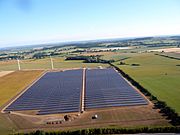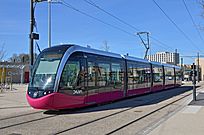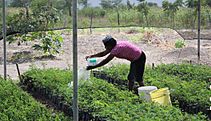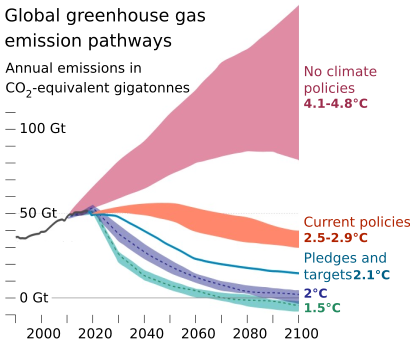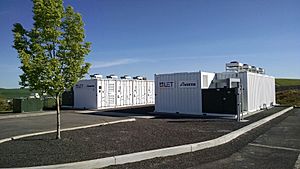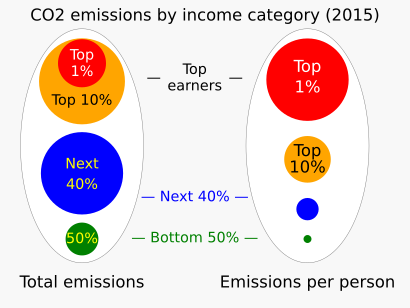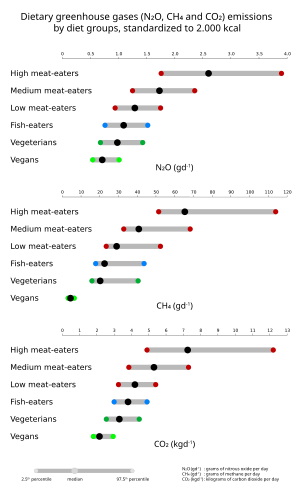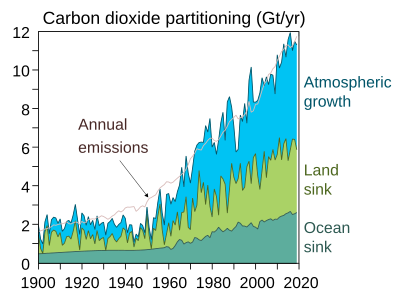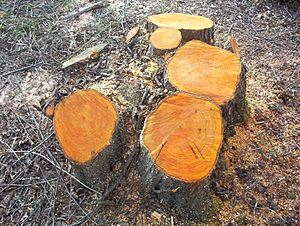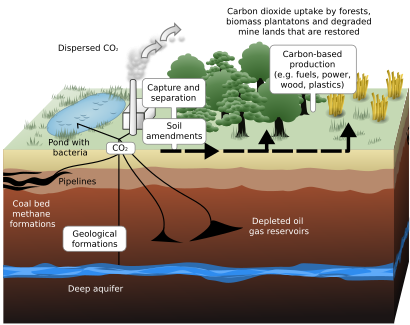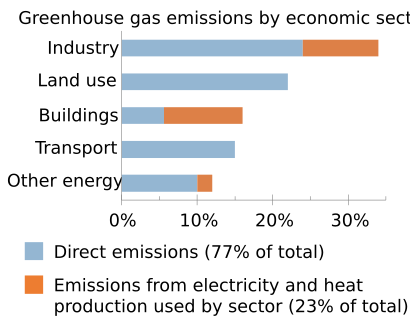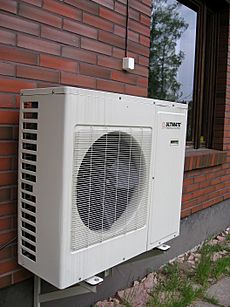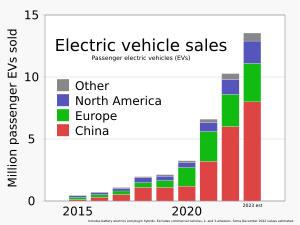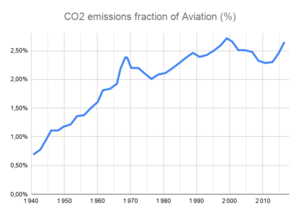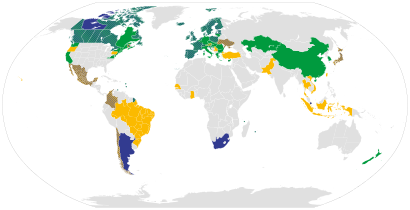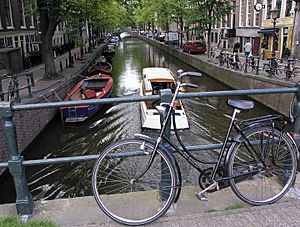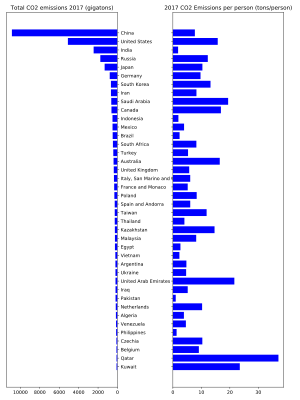Climate change mitigation facts for kids
Climate change mitigation means taking action to slow down climate change. This is done by reducing the amount of greenhouse gases we release into the air. It also involves finding ways to remove these gases from the atmosphere. The main reason global temperatures are rising is because we burn a lot of fossil fuels like coal, oil, and natural gas.
We can reduce emissions by switching to sustainable energy sources. We can also save energy and use it more efficiently. Another way is to remove carbon dioxide (CO2) from the air. This can be done by planting more forests and restoring wetlands. Experts call these efforts carbon sequestration. Governments and companies are working together to cut emissions. Their goal is to stop dangerous climate change and keep global warming below 2 °C, or even 1.5 °C.
Solar energy and wind power are great ways to reduce emissions at a low cost. Sometimes, the sun and wind are not always available. But we can fix this with energy storage and better electrical grids. This includes sending electricity over long distances and managing when we use power. We can also use more types of renewable energy.
We can also reduce emissions from things that burn fossil fuels directly, like cars and heating systems. We can do this by making them electric. If the electricity comes from renewable sources, it helps even more. Using heat pumps and electric vehicles makes us use energy better. If factories have to create carbon dioxide, they can use carbon capture and storage to trap it.
Farming also creates greenhouse gases like methane and nitrous oxide. We can cut these emissions by wasting less food. Eating more plant-based diets, protecting ecosystems, and improving farming methods also help. Changing how we get energy, run factories, and farm can reduce emissions. So can changes in what we buy and how we travel.
Many countries use policies like carbon taxes or carbon emission trading. They also support renewable energy and reduce help for fossil fuels. Current plans might still lead to about 2.7 °C of warming by 2100. This is more than the 2015 Paris Agreement goal. But limiting warming to 2 °C could actually bring more economic benefits than costs.
Contents
- What is Climate Change Mitigation?
- How Many Emissions Are There?
- Clean Energy Solutions
- Using Less Energy
- Protecting and Growing Carbon Sinks
- Other Ways to Capture and Store CO2
- Reducing Emissions by Sector
- Benefits of Mitigation
- Costs and Funding
- Policies and Plans
- History of Mitigation Efforts
- Risks of Mitigation Measures
- See also
What is Climate Change Mitigation?
Climate change mitigation aims to protect our ecosystems and human life. This means we need to make big cuts in greenhouse gas emissions. The Intergovernmental Panel on Climate Change (IPCC) says mitigation is "a human action to reduce emissions or improve the ways we absorb greenhouse gases."
Some people talk about solar geoengineering (SRM) as a way to fight climate change. SRM would change how much sunlight reaches Earth. This is different from reducing greenhouse gases. The IPCC sees SRM as a way to reduce climate risks, not as a main mitigation option.
We can use many different ways to reduce warming at the same time. There isn't just one solution to limit global warming to 1.5 or 2 °C. Here are some main ways we can help:
- Sustainable energy and sustainable transport
- Energy conservation and using energy wisely
- Sustainable agriculture and green industry
- Improving carbon sinks and removing carbon dioxide (CDR)
The IPCC defines carbon dioxide removal as human activities that take CO2 out of the air. This includes growing more forests or using special technologies.
How Many Emissions Are There?
Greenhouse gas emissions from human activities make the greenhouse effect stronger. This causes climate change. Most of these emissions are carbon dioxide from burning fossil fuels like coal, oil, and natural gas. Human activities have increased carbon dioxide in the air by about 50% since before the Industrial Revolution.
In the 2010s, we released a record 56 billion tons of emissions each year. In 2016, energy for electricity, heat, and transport caused 73.2% of greenhouse gas emissions. Factories caused 5.2%, waste 3.2%, and farming and land use 18.4%.
Making electricity and transportation are big sources of emissions. The largest single source is coal-fired power stations, which cause 20% of greenhouse gas emissions. Cutting down forests (Deforestation) and other land changes also release carbon dioxide and methane.
The biggest sources of methane from humans are farming and leaks from the fossil fuel industry. Livestock (like cows) are the largest source of methane in farming. Farm soils release nitrous oxide, partly because of fertilizers. Many countries have agreed to reduce fluorinated gases from coolants.
Carbon dioxide (CO2) is the main greenhouse gas we release. Methane (CH
4) has a similar short-term effect. Nitrous oxide (N2O) and fluorinated gases (F-Gases) play a smaller role. Livestock and their waste produce 5.8% of all greenhouse gas emissions.
Scientists measure greenhouse gases in "carbon dioxide equivalents" (CO2 equivalents). This helps compare how much different gases warm the planet. Satellites are now used to find and measure greenhouse gas emissions and deforestation. Before, scientists mostly used estimates or government reports.
How Much Do We Need to Cut?
The United Nations Environment Programme (UNEP) said in 2022 that we need to almost halve emissions. To limit global warming to 1.5°C, global emissions must drop by 45% by 2030. They need to keep falling fast after that. This is to avoid using up our remaining "carbon budget." The report said the world needs big changes across the whole economy, not just small steps.
In 2022, the IPCC warned that greenhouse gas emissions must peak by 2025 at the latest. They then need to drop by 43% by 2030. This gives us a good chance of limiting warming to 1.5 °C. The UN Secretary-General, António Guterres, said: "Main emitters must drastically cut emissions starting this year."
What Countries Have Promised
As of November 2021, the Climate Action Tracker said that global temperatures would rise by 2.7 °C by 2100 with current policies. If countries keep their 2030 promises, it would be 2.4 °C. If all long-term goals are met, the rise would be 2.1 °C. If all announced targets are fully achieved, the temperature rise would peak at 1.9 °C and go down to 1.8 °C by 2100.
Experts track these promises in the Global Climate Action Portal - Nazca. Scientists check if countries are meeting their goals. It seems most international goals set for 2020 were not met.
At the 2021 United Nations Climate Change Conference in Glasgow, researchers looked at countries causing 85% of greenhouse gas emissions. Only four countries or groups (the EU, UK, Chile, and Costa Rica) had detailed plans to meet their 2030 targets. These four cause 6% of global emissions.
In 2021, the US and EU started the Global Methane Pledge. They aim to cut methane emissions by 30% by 2030. Many other countries have joined this effort.
Clean Energy Solutions
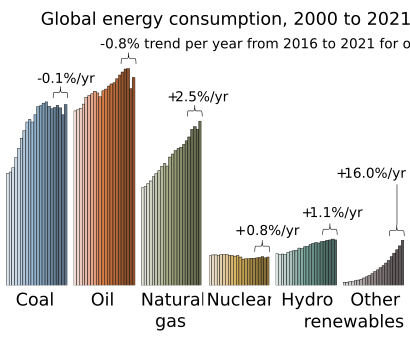
Our energy system (how we get and use energy) is the main source of carbon dioxide (CO2) emissions. We need to quickly and deeply cut carbon dioxide and other greenhouse gas emissions from energy. This is key to limiting global warming to below 2 °C. The IPCC suggests using less fossil fuel and making more energy from low-carbon sources. We also need to use more electricity and other clean energy types.
Most plans involve a big increase in renewable energy and better energy efficiency. We need to speed up renewable energy use six times faster than in 2015 to keep warming under 2 °C.
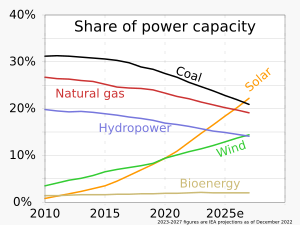
Renewable energy is becoming cheaper. In 2020, onshore wind and solar power were the cheapest ways to make new electricity in many places. Renewables might have higher costs for storing energy. But fossil fuels have higher cleanup costs. A carbon price can make renewable energy more competitive.
Solar and Wind Power
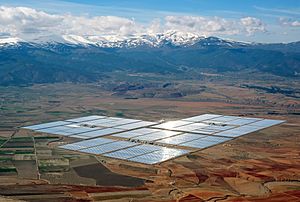
Wind and sun can provide lots of clean energy at good prices. The IPCC believes these two options have the biggest potential to cut emissions cheaply before 2030.
Solar photovoltaics (PV) is now the cheapest way to make electricity in many parts of the world. Solar power has grown very fast, almost doubling every three years since the 1990s. Another technology is concentrated solar power (CSP). This uses mirrors to focus sunlight. CSP can store energy for a few hours to provide power in the evening. Solar water heating also doubled between 2010 and 2019.
Areas far from the equator have the most potential for wind power. Offshore wind farms are more expensive but produce more energy and are more stable. Wind power is usually stronger in winter when solar power is low. So, combining wind and solar power creates a more balanced energy system.
Other Renewable Energy Sources
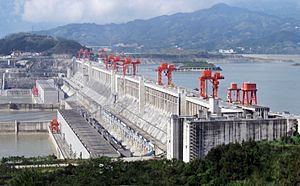
Other well-known renewable energy forms include hydropower, bioenergy, and geothermal energy.
- Hydroelectricity uses water power and is very important in countries like Brazil and Norway. But there are limits to where it can be used and it can affect the environment. Tidal power can be used in coastal areas.
- Bioenergy can provide energy for electricity, heat, and transport. Burning plant material (biomass) releases CO2, but the plants absorb CO2 as they grow. How we produce and use bioenergy affects its overall emissions. Airplanes are starting to use renewable biofuels.
- Geothermal power uses heat from inside the Earth. It is used in 26 countries for electricity and 70 countries for heating.
Making Variable Renewables Work Together
Wind and solar power don't always produce electricity when we need it. To get reliable electricity from these sources, our power systems need to be flexible. Most power grids were built for steady energy sources like coal plants. As we add more solar and wind, we must change the system to match supply and demand.
There are many ways to make the electricity system more flexible. Wind and solar often balance each other out daily and seasonally. There's more wind at night and in winter when solar is low. Connecting different regions with long-distance power lines also helps reduce changes. We can also shift when we use energy. Energy demand management and smart grids help match energy use to when variable energy production is highest.
Building extra wind and solar capacity can ensure enough electricity even in bad weather. Sometimes, if there's too much electricity, we might need to stop generating it if we can't use or store the extra.
Energy storage helps with renewable energy that isn't always on. The most common storage method is pumped-storage hydroelectricity. This needs places with big height differences and water. Batteries are also widely used. They usually store electricity for short times. Batteries are not practical for very large, long-term energy storage because of their size and cost.
Nuclear Power
Nuclear power could work with renewables for electricity. However, there are environmental and safety risks to consider. Building new nuclear reactors takes about 10 years, which is longer than building wind and solar farms. But extending the life of existing nuclear plants can be cheaper than building new solar or wind projects.
Using Less Energy
We can reduce our demand for products and services that cause greenhouse gas emissions. 1. Change our habits: For example, eating less meat is a good way for individuals to fight climate change. 2. Improve infrastructure: Good public transport networks can reduce the need for cars. 3. Use better technology: A well-insulated house uses less energy for heating and cooling.

These "demand-side" actions help people make choices to lower their carbon footprint. For example, people with higher incomes often cause more emissions. If they reduce their emissions, they can be role models for a low-carbon lifestyle. Governments can help by promoting ideas like the circular economy, where we reuse and recycle more.
Saving Energy and Using it Wisely
In 2018, global energy demand was over 161,000 terawatt hours (TWh). This includes electricity, transport, and heating. A lot of heat is wasted in power plants and car engines. The actual energy used was much lower, at 116,000 TWh.
Energy conservation means using less energy. One way is to use energy more efficiently. This means getting the same service with less energy. Another way is to simply use less of a service, like driving less. Energy conservation is a top priority for sustainable energy. We can save energy by reducing waste and improving technology.
Efficient energy use means reducing the energy needed for products and services. We often call it energy efficiency. Better energy efficiency in buildings, factories, and transport could cut the world's energy needs by one-third by 2050. This would help reduce greenhouse gas emissions. For example, insulating a building helps it use less energy for heating and cooling.
Lifestyle Changes
Individual action on climate change includes personal choices in many areas. These are diet, travel, home energy use, and what we buy. People who want to reduce their carbon footprint can do things like avoid frequent flying, use electric cars, eat mostly plant-based diets, and make clothes and electronics last longer. These actions are easier for people in rich countries with high-consumption lifestyles. It's harder for those with lower incomes to make these changes.
Excessive consumption causes more climate change than population growth. The richest 10% of people cause about half of all lifestyle emissions.
Changing Diets
Some scientists say that avoiding meat and dairy is the single biggest way to reduce your environmental impact. If everyone became vegetarian, food-related greenhouse gas emissions could drop by 63% by 2050. China introduced new diet guidelines in 2016 to cut meat consumption by 50%. This could reduce emissions by 1 billion tons per year by 2030.
Overall, food causes the largest share of consumption-based greenhouse gas emissions. It's responsible for almost 20% of the global carbon footprint. Nearly 15% of all human-caused greenhouse gas emissions come from raising livestock.
Eating more plant-based diets would help fight climate change. Reducing meat consumption, especially, would help cut methane emissions. If rich countries switched to plant-based diets, huge amounts of land used for animal farming could return to their natural state. This could trap 100 billion tons of CO2 by the end of the century. Studies show that plant-based diets greatly reduce emissions, water pollution, and land use (by 75%). They also reduce harm to wildlife and water use.
Protecting and Growing Carbon Sinks
An important way to fight climate change is to "preserve and enhance carbon sinks." This means managing Earth's natural carbon sinks to help them remove more CO2 from the air and store it for a long time. This is called carbon sequestration. The IPCC defines a sink as "Any process or activity that removes a greenhouse gas from the atmosphere." Globally, the two most important carbon sinks are plants and the ocean.
To help ecosystems trap more carbon, we need changes in farming and forestry. Examples include stopping deforestation and bringing back natural ecosystems by reforestation. Plans to limit global warming to 1.5 °C usually involve using carbon dioxide removal methods on a large scale. There are some worries about relying too much on these technologies and their environmental effects. However, restoring ecosystems and reducing land conversion are among the best ways to cut emissions before 2030.
The 2022 IPCC report calls land-based mitigation options "AFOLU mitigation options." This stands for "agriculture, forestry and other land use." The report says that protecting, managing, and restoring forests and other ecosystems (like wetlands and grasslands) has a high potential to reduce emissions. Reducing deforestation in tropical areas is especially helpful. These activities could reduce emissions by 4.2 to 7.4 billion tons of carbon dioxide equivalent (GtCO2 -eq) per year.
Forests
Protecting Forests
The Stern Review in 2007 said that stopping deforestation was a very cost-effective way to reduce greenhouse gas emissions. About 95% of deforestation happens in tropical areas, mainly to clear land for farming. One way to protect forests is to give land rights to the local people who live there. Often, land is given to big companies that cut down trees. Conservation plans that remove people from their land can sometimes lead to more exploitation. This happens because local people might then work for these companies to survive.
Proforestation means helping forests grow to their full natural potential. This is a good way to fight climate change. Forests that have regrown on old farmland often have less biodiversity than original old-growth forests. Original forests also store 60% more carbon than these new forests. Strategies include letting nature take over (rewilding) and creating wildlife corridors.
Forestry mitigation measures work slowly. They can also affect food prices. And they might cause other climate effects from indirect land use changes. For these measures to work long-term, we need to think carefully about their environmental impact. They also need to be part of wider sustainable land use plans.
Planting New Trees and Restoring Forests
Afforestation is planting trees where there were no trees before. Plans for new plantations covering huge areas (up to 4000 million hectares) suggest they could store over 900 billion tons of carbon until 2100. But these plantations would need to be so big that they would take over most natural ecosystems or reduce food production. So, they are not a full replacement for cutting emissions aggressively. An example is the Trillion Tree Campaign.
Reforestation is replanting trees in areas where forests have been cut down or damaged. Reforestation could save at least 1 billion tons of CO2 per year, costing about $5–15 per ton of CO2. Restoring all damaged forests worldwide could capture about 205 billion tons of carbon. With more intensive agriculture and urbanization, there is more abandoned farmland. Some estimates say that for every acre of old-growth forest cut down, more than 50 acres of new secondary forests are growing. In some countries, helping trees regrow on abandoned farmland could make up for years of emissions.
Planting new trees can be expensive and risky. For example, about 80% of trees planted in the Sahel die within two years. Reforestation has a higher carbon storage potential than afforestation. In mangrove areas, reforestation is expected to trap 60% more carbon per hectare in the 40 years after planting. Coastal wetlands could see a 4.3-5.1% increase in annual CO2 uptake by reforesting available mangrove areas.
Even areas that have been deforested for a long time can still have an "underground forest" of living roots and tree stumps. Helping native species grow naturally is cheaper than planting new trees and they are more likely to survive. This can include pruning and coppicing to speed up growth. This also provides wood for fuel, which helps prevent more deforestation. These practices, called farmer-managed natural regeneration, are centuries old. The biggest problem is that governments often own the trees. They sell timber rights to businesses, which makes locals uproot seedlings because they see them as a problem. Giving legal help to locals and changing property laws, like in Mali and Niger, have led to big positive changes. Scientists call this the largest positive environmental change in Africa. You can even see the border between Niger and the drier land in Nigeria from space, where the law hasn't changed.
Soils
There are many ways to increase carbon in soil. This makes it complex to measure. One good thing is that these methods have fewer downsides than other methods like BECCS or planting new forests.
Globally, protecting healthy soils and restoring the soil's ability to absorb carbon could remove 7.6 billion tons of carbon dioxide from the air each year. This is more than the annual emissions of the US. Trees trap CO2 as they grow above ground. They also release large amounts of carbon below ground through their roots. Trees help build a "soil carbon sponge." Carbon in wood is released as CO2 when burned. If dead wood is left untouched, only some carbon returns to the atmosphere as it breaks down.
Methods that increase carbon in soil include no-till farming, covering soil with plant remains, and crop rotation. Organic farming uses these techniques more than traditional farming. Since only 5% of US farmland currently uses no-till and residue mulching, there's a big chance to trap more carbon.
Farming can reduce soil carbon and make soil unable to support life. However, conservation farming can protect carbon in soils and repair damage over time. Planting cover crops is a form of climate-smart agriculture. Scientists have found the best ways to increase soil organic carbon in European soils. These include changing cropland to grassland, adding straw to soil, reducing tillage, and using cover crops.
Regenerative agriculture includes conservation tillage, diverse crops, rotation, and cover crops. It also means disturbing the soil as little as possible and helping carbon stay in soils. It has other benefits, like improving soil health and crop yields.
Another way to reduce emissions is to make biochar and store it in soils. Biochar is the solid material left after heating biomass without oxygen. Biochar production releases half the carbon from the biomass (either into the air or captured with CCS). The other half stays in the stable biochar. It can last in soil for thousands of years. Biochar can make acidic soils more fertile and increase agricultural productivity. When biochar is made, heat is released, which can be used as bioenergy.
Wetlands
Wetland restoration is an important way to reduce emissions. It has a good potential to help, uses limited land, and has low costs and downsides. Wetlands do two important things for climate change. They can trap carbon by turning carbon dioxide into plant material through photosynthesis. They also store and control water. Wetlands store about 45 million tons of carbon globally each year.
Some wetlands release a lot of methane. Some also release nitrous oxide. Peatlands cover only 3% of the Earth's land. But they store up to 550 billion tons of carbon. This is 42% of all soil carbon and more than all other plants, including forests. Threats to peatlands include draining them for farming and cutting down trees. Peat is also often sold for compost. We can restore damaged peatlands by blocking drainage channels and letting natural plants grow back.
Mangroves, salt marshes, and seagrasses make up most of the ocean's plant habitats. They are only 0.05% of the plant material on land. But they store carbon 40 times faster than tropical forests. Bottom trawling, digging for coastal development, and fertilizer runoff have damaged coastal habitats. For example, 85% of oyster reefs worldwide have been removed in the last two centuries. Oyster reefs clean water and help other species grow. They also reduce the impact of climate change by weakening waves from hurricanes and reducing erosion from rising sea levels. Restoring coastal wetlands is thought to be cheaper than restoring inland wetlands.
Deep Ocean
These options focus on storing carbon in ocean reservoirs. They include adding nutrients to the ocean, increasing ocean alkalinity, or speeding up natural rock weathering. The IPCC found in 2022 that ocean-based mitigation options are currently used only a little. But they have a large potential for the future. They could remove 1–100 billion tons of CO2 per year. Their costs are about 40–500 USD per ton of CO2. Most of these options could also help reduce ocean acidification.
Blue carbon management is another type of ocean-based carbon dioxide removal (CDR). It can involve both land and ocean measures. The term usually refers to how tidal marshes, mangroves, and seagrasses can trap carbon. Some of these efforts can also happen in deep ocean waters, where most ocean carbon is stored. These ecosystems can help fight climate change and also help us adapt to it. But when blue carbon ecosystems are damaged, they release carbon back into the air. There is growing interest in blue carbon. Scientists have found that these ecosystems can remove much more carbon per area than land forests. However, how well blue carbon works long-term is still being discussed.
Enhanced Weathering
Enhanced weathering could remove 2–4 billion tons of CO2 per year. This process tries to speed up natural weathering. It involves spreading finely ground rock, like basalt, onto surfaces. This makes chemical reactions between rocks, water, and air happen faster. It removes carbon dioxide from the atmosphere and stores it permanently in solid minerals or ocean water. Costs are estimated to be 50-200 USD per ton of CO2.
Other Ways to Capture and Store CO2
Besides traditional land-based ways to remove carbon dioxide (CO2) from the air, new technologies are being developed. These could reduce CO2 emissions and lower existing CO2 levels in the atmosphere. Carbon capture and storage (CCS) is a way to fight climate change by capturing CO2 from big sources like cement factories or power plants that burn biomass. It then stores the CO2 safely underground instead of releasing it into the air. The IPCC estimates that stopping global warming would cost twice as much without CCS.
Bioenergy with carbon capture and storage (BECCS) builds on CCS. It aims to lower atmospheric CO2 levels. This process uses biomass (plants) grown for bioenergy. The biomass creates energy (like electricity or heat) when burned. The CO2 that the plants took from the atmosphere as they grew is then captured. It is stored underground or used as biochar on land. This effectively removes it from the atmosphere. This makes BECCS a "negative emissions technology."
Scientists estimated in 2018 that BECCS could remove 0-22 billion tons of CO2 per year. As of 2022, BECCS was capturing about 2 million tons of CO2 annually. The cost and availability of biomass limit how widely BECCS can be used. BECCS is a big part of plans to reach climate targets beyond 2050 in many models. But some scientists are worried about the risk of losing biodiversity.
Direct air capture is a process that captures CO2 directly from the air around us. This is different from CCS, which captures carbon from specific sources like factory smokestacks. It creates a concentrated stream of CO2 for storage, use, or to make carbon-neutral fuel. These artificial processes vary, and there are concerns about their long-term effects.
Reducing Emissions by Sector
Buildings
Buildings cause 23% of global CO2 emissions related to energy. About half of this energy is used for heating and water heating. Good building insulation can greatly reduce the energy needed. Heat pumps can also help manage energy use and integrate variable renewable sources into the grid. Solar water heating uses the sun's heat directly.
We can also build new homes using passive solar building design, low-energy building, or zero-energy building techniques. Buildings can be designed to be more energy-efficient for cooling. This can be done by using lighter, more reflective materials in cities.
Heat pumps efficiently heat and cool buildings. A modern heat pump moves about three to five times more heat energy than the electrical energy it uses. Refrigeration and air conditioning cause about 10% of global CO2 emissions. This is from fossil fuel energy and the use of fluorinated gases. Other cooling systems, like passive cooling building design, can reduce the need for air conditioning.
Energy use for cooling is likely to rise a lot. This is because of increasing heat and more devices in poorer countries. Of the 2.8 billion people in the hottest parts of the world, only 8% have air conditioners. In contrast, 90% of people in the US and Japan have them. By improving energy efficiency and switching away from super-polluting coolants, the world could avoid 210–460 billion tons of CO2 emissions over the next four decades. Switching to renewable energy for cooling has two benefits. Solar energy production peaks at midday, which matches the need for cooling. Also, cooling has a big potential for managing the electric grid's load.
Transport
Transportation causes 15% of emissions worldwide. Using more public transport, low-carbon freight transport, and cycling are important for reducing transport emissions.
Electric vehicles and environmentally friendly trains help reduce fossil fuel use. Electric trains are usually more efficient than air travel and truck transport. Other ways to be efficient include better public transport, smart mobility, carsharing, and electric hybrids. Moving away from a car-focused transport system towards low-carbon public transport is important.
Heavy, large personal vehicles (like cars) use a lot of energy and take up much urban space. Many other transport options can replace them. The European Union has made smart mobility part of its European Green Deal. In smart cities, smart mobility is also key.
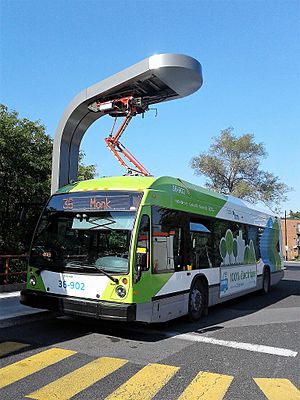
The World Bank helps lower-income countries buy electric buses. They cost more to buy than diesel buses. But lower running costs and health benefits from cleaner air can make up for the higher price.
Experts predict that between one-quarter and three-quarters of cars on the road by 2050 will be electric vehicles. Hydrogen might be a solution for long-distance heavy trucks if batteries are too heavy.
Shipping
In shipping, using liquefied natural gas (LNG) as fuel is driven by rules about emissions. Ship operators must switch from heavy fuel oil to more expensive oil-based fuels, use costly exhaust gas treatments, or switch to LNG engines. However, methane leaks from LNG engines reduce its benefits. Maersk, the world's biggest container shipping line, warns against investing in fuels like LNG. The company says green ammonia is a preferred future fuel. It plans to have the first carbon-neutral ship by 2023, running on carbon-neutral methanol. Cruise operators are testing partially hydrogen-powered ships.
Hybrid and all-electric ferries are good for short distances. Norway aims for an all-electric fleet by 2025.
Air Transport
Jet airliners contribute to climate change by releasing carbon dioxide, nitrogen oxides, and other particles. Their warming effect is estimated to be 1.3–1.4 times that of CO2 alone. In 2018, global commercial flights caused 2.4% of all CO2 emissions.
The aviation industry has become more fuel-efficient. But overall emissions have risen because more people are flying. By 2020, aviation emissions were 70% higher than in 2005, and they could grow by 300% by 2050.
We can reduce aviation's environmental impact by making planes more fuel-efficient. Optimizing flight routes to lower non-CO2 effects (from nitrogen oxides or particles) can also help. Aviation biofuel, carbon emission trading, and carbon offsetting can lower CO2 emissions. Banning Short-haul flight bans, using train connections, making personal choices, and taxing flights can lead to fewer flights. Hybrid electric aircraft, electric aircraft, or hydrogen-powered aircraft may replace fossil fuel planes.
Experts expect aviation emissions to rise in most predictions, at least until 2040. They currently make up 180 million tons of CO2 or 11% of transport emissions. Aviation biofuel and hydrogen can only cover a small part of flights in the coming years. Experts expect hybrid planes to start commercial regional flights after 2030. Battery-powered planes are likely to enter the market after 2035.
Agriculture, Forestry, and Land Use
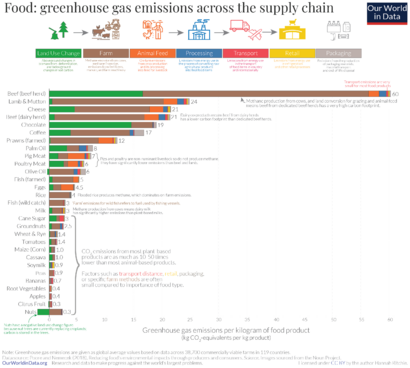
Almost 20% of greenhouse gas emissions come from farming and forestry. Ways to reduce emissions in the food system fall into four groups: changing demand, protecting ecosystems, reducing emissions on farms, and reducing emissions in supply chains. On the demand side, wasting less food is a good way to cut food emissions. Eating less meat and more plant-based diets also helps.
Cattle are a major cause of global warming, causing 21% of global methane emissions. When rainforests are cut down for grazing, the impact is even higher. In Brazil, producing 1 kg of beef can release up to 335 kg of CO2 equivalent. Other livestock, manure management, and rice farming also release greenhouse gases.
Important ways to reduce greenhouse gas emissions from livestock include breeding better animals, using special bacteria in their stomachs, vaccines, and changing their diets. Other options are to eat less meat from animals like cows and switch to alternatives like milk substitutes and meat analogues. Animals like chickens produce far fewer greenhouse gases.
We can cut methane emissions in rice farming by managing water better. This includes combining dry seeding with one water removal, or using a cycle of wetting and drying. This can reduce emissions by up to 90% compared to full flooding and even increase yields.
Industry
Industry is the biggest source of greenhouse gases when direct and indirect emissions are counted. Electrification can reduce emissions from industry. Green hydrogen can play a big role in energy-intensive industries where electricity isn't an option. Other ways to reduce emissions include the steel and cement industries switching to less polluting production methods. Products can be made with less material to reduce emissions. Industrial processes can also be made more efficient. Finally, circular economy measures reduce the need for new materials. This also saves emissions from mining or collecting those materials.
Making cement with less carbon needs new technologies and investment. Bioconcrete is one possibility to reduce emissions. But no technology for this is fully ready yet. So, CCS will be needed, at least for a while. Blast furnaces could be replaced by hydrogen direct reduced iron and electric arc furnaces.
Coal, gas, and oil production often have significant methane leaks. In the early 2020s, some governments recognized this problem and made rules. Methane leaks at oil and gas wells and processing plants are often cheap to fix in countries that can easily trade gas. There are also leaks in countries where gas is cheap, like Iran, Russia, and Turkmenistan. Almost all of these leaks can be stopped by replacing old parts and preventing routine flaring. Coalbed methane can keep leaking even after a mine closes. But it can be captured by drainage or ventilation systems. Fossil fuel companies don't always have financial reasons to fix methane leaks.
Benefits of Mitigation
Health and Well-being
Reducing climate change has big health benefits. Actions to fight climate change can not only prevent future health problems but also improve health right away. For example, reducing air pollution from burning fossil fuels helps both climate change and human health. Air pollution causes many deaths each year. Some estimates say as many as 8.7 million extra deaths in 2018.
Mitigation policies can also encourage healthier diets (like less red meat), more active lifestyles, and more time in green urban spaces. Access to green urban spaces also helps mental health. More green and blue infrastructure can reduce the urban heat island effect. This means less heat stress for people. Studies suggest that reducing how much we consume generally helps 18 parts of our well-being.
Future sustainable plans could lead to fewer deaths from air pollution (1.18 million), diet-related issues (5.86 million), and lack of physical activity (1.15 million) across nine countries by 2040. These benefits come from reducing greenhouse gas emissions and related actions that reduce exposure to harmful pollution. They also come from better diets and safe physical activity. Globally, the cost of limiting warming to 2 °C is less than the value of the extra years of life gained from cleaner air. In India and China, it's much less.
In transportation, mitigation strategies could lead to fairer access to transport services and reduce traffic jams. Addressing inequality can also help with climate change mitigation. Focusing on health in national climate plans could help countries be more ambitious and gain health benefits.
Climate Change Adaptation
Some mitigation actions also help us adapt to climate change. This is true for many nature-based solutions. For example, in cities, green and blue infrastructure (like urban forests, street trees, green roofs, and urban agriculture) helps both mitigation and adaptation. Mitigation happens by protecting and expanding carbon sinks and reducing building energy use. Adaptation benefits come from things like reduced heat stress and lower flood risk.
Costs and Funding
Many things affect how much mitigation costs. These include the starting point we compare to, how costs are modeled, and ideas about future government policies. Costs for specific regions depend on how many emissions are allowed and when actions are taken.
Mitigation costs will change based on how and when emissions are cut. Acting early and planning well will keep costs down. Globally, the benefits of keeping warming under 2 °C are greater than the costs.
Economists estimate that climate change mitigation will cost between 1% and 2% of GDP. While this is a large amount, it's much less than the money governments give to the fossil fuel industry. The International Monetary Fund estimated this at over $5 trillion per year.
The economic effects of mitigation vary a lot across regions and households. This depends on how policies are designed and how much countries work together. Delaying global cooperation increases policy costs, especially in regions that currently use a lot of carbon. Plans with the same carbon values show higher mitigation costs in carbon-heavy regions, fossil-fuel exporting regions, and poorer regions. Measuring costs only in GDP or money can underestimate the effects on households in poorer countries. The real effects on their well-being are much larger.
Cost–benefit analysis might not be good for looking at all of climate change mitigation. But it is useful for comparing a 1.5 °C target to a 2 °C target. One way to estimate the cost of reducing emissions is to look at the likely costs of technology and production changes. Policymakers can compare the costs of different methods to see how much they can reduce emissions over time. The costs of different measures will vary by country, industry, and over time.
Avoiding Climate Change Costs
We can avoid some of the costs of effects of climate change by limiting climate change. According to the Stern Review, doing nothing could be like losing at least 5% of global GDP every year, forever. This could be up to 20% of GDP or more if we include more risks and impacts. But fighting climate change will only cost about 2% of GDP. It might not be a good financial idea to delay big cuts in greenhouse gas emissions.
Mitigation solutions are often judged by their costs and how much greenhouse gas they reduce. This doesn't always consider the direct effects on human well-being.
Sharing Emission Reduction Costs
Reducing emissions at the speed and scale needed to limit warming to 2 °C or below means big economic and structural changes. These bring up many concerns about how costs are shared across regions, income groups, and industries.
There have been different ideas on how to share the responsibility for cutting emissions. These include ideas like everyone being equal, meeting basic needs, sharing proportionally, and the polluter-pays principle. One specific idea is "equal per capita entitlements." This means emissions are shared based on a country's population. Another idea is to share emissions based on historical or total emissions.
Funding Mitigation Efforts
To balance economic development with cutting carbon emissions, developing countries need special financial and technical support. The IPCC found that more support would also help fix unfairness in financial and economic vulnerability to climate change. One way to do this is the Kyoto Protocol's Clean Development Mechanism (CDM).
Policies and Plans
City Policies and Urban Planning
Cities have a big chance to reduce greenhouse gas emissions. In 2020, they emitted 28 billion tons of CO2 and CH
4 from producing and consuming goods and services. Climate-smart urban planning aims to reduce urban sprawl to cut down on travel distances. This lowers transport emissions. It supports mixed-use areas and public transport. Walking, cycling, and sharing vehicles can reduce city emissions. Urban forestry, lakes, and other green and blue infrastructure can reduce emissions directly and indirectly by lowering energy demand for cooling. Personal cars are very inefficient for moving people. Public transport and bicycles are much more efficient in cities. Switching from cars by improving walkability and cycling infrastructure is either free or good for a country's economy. Methane emissions from municipal solid waste can be reduced by separating waste, composting, and recycling.
National Policies
Climate change mitigation policies can have big and complex effects on people and countries, both good and bad. It's important to design policies well and make them fair. Otherwise, climate change mitigation measures can cost poor households more money.
The best and most cost-effective way to cut emissions in the energy sector is to use a mix of measures. These include market tools like taxes and permits, standards, and information policies.
Types of national policies that help fight climate change include:
- Rules and standards: These set technology or performance rules. They can help when people don't have enough information. For example, fuel-efficiency standards for cars.
- Market-based tools: Like emission taxes and charges. An emissions tax makes companies pay a fixed fee for every ton of greenhouse gas they release. If everyone paid the same tax, they would choose the cheapest way to cut emissions first. But in the real world, markets aren't perfect.
- Tradable permits: A permit system can limit emissions. A certain number of permits are given out, equal to the emission limit. Each company must have enough permits for its actual emissions. This system can be cost-effective if costs are not too high and the market works well.
- Voluntary agreements: These are agreements between governments and industries. They might be about research or specific targets. But there's a risk that some participants might not follow the agreement or benefit without doing their part.
- Information: Lack of information can stop people from saving energy or reducing emissions. Policies in this area include telling the public about saving energy with home heating or emissions from meat.
- Research and development: Some areas, like soil, might need national research because they differ by country. Technologies might need financial help to become widely used, like floating wind power.
- Low-carbon power: Governments might make it easier to build solar and onshore wind farms. They might also help fund risky technologies like nuclear power.
- Demand-side management: This aims to reduce energy demand, for example, through energy audits, labeling, and rules.
- Adding or removing subsidies:
* A subsidy for greenhouse gas reductions pays companies a certain amount for every ton of greenhouse gas reduced or captured. Subsidies are usually less efficient than taxes. * Creating subsidies and financial help. For example, energy subsidies support clean energy that isn't yet profitable, like tidal power. * Stopping unhelpful subsidies. Many countries give money for activities that cause emissions, like in farming and energy, or indirect help for transport.
- A Green Marshall Plan. This suggests using money created by central banks to fund green infrastructure globally.
- Market liberalization: Energy markets have been changed in several countries. These policies mainly aim to increase competition. But they can also have a big impact on emissions.
Phasing Out Fossil Fuel Subsidies
Many governments support fossil fuels by giving them money or tax breaks. These fossil fuel subsidies make fossil fuels cheaper than they should be. This encourages people to use more of them, which increases greenhouse gas emissions. Removing these subsidies would help reduce emissions. It would also save governments money and help them reach their climate goals.
Carbon Pricing
Making greenhouse gas emissions more expensive can make fossil fuels less competitive. It also encourages investments in low-carbon energy sources. More and more countries are using a fixed carbon tax or participating in carbon emission trading (ETS) systems. In 2021, over 21% of global greenhouse gas emissions were covered by a carbon price. This was a big increase due to China starting its national carbon trading scheme.
Trading schemes can limit emission allowances to reach certain reduction targets. However, too many allowances keep most ETS prices low, around $10. This includes the Chinese ETS, which started at $7/tCO2 in 2021. One exception is the European Union Emission Trading Scheme, where prices started to rise in 2018. They reached about €80/tCO2 in 2022. This adds costs to electricity from coal and gas.
Industries that use a lot of energy and have high emissions often pay very low or no energy taxes. Methane emissions from fossil fuel extraction are sometimes taxed. But methane and nitrous oxide from farming are usually not taxed.
International Agreements
Almost all countries are part of the United Nations Framework Convention on Climate Change (UNFCCC). The main goal of the UNFCCC is to stabilize greenhouse gas levels in the atmosphere. This is to prevent dangerous human interference with the climate.
The Montreal Protocol has helped climate change mitigation efforts, even though it wasn't designed for it. The Montreal Protocol is an international treaty that successfully reduced emissions of ozone-depleting substances like CFCs. These are also greenhouse gases.
Paris Agreement
The Paris Agreement is a big international treaty on climate change. It was adopted in 2015. Its main goal is to keep the global average temperature rise well below 2 °C (3.6 °F) above pre-industrial levels. It also aims to limit the increase to 1.5 °C (2.7 °F), as this would greatly reduce the risks and effects of climate change.
The Paris Agreement is a legally binding international treaty. It was signed by 196 countries in Paris on December 12, 2015. It came into force on November 4, 2016.
Under the Paris Agreement, each country decides its own climate action plan, called a Nationally Determined Contribution (NDC). These NDCs set targets for reducing greenhouse gas emissions. The agreement also includes rules for reporting and reviewing these plans.
History of Mitigation Efforts
Historically, efforts to deal with climate change have happened at a global level. They involve trying to reach agreements at the United Nations, under the United Nations Framework Convention on Climate Change (UNFCCC). This has been the main way to get many countries to act on a worldwide issue. The Montreal Protocol in 1987 shows that this approach can work. But some critics say the top-down approach of only using UNFCCC agreements is not effective. They suggest bottom-up approaches instead.
The Kyoto Protocol to the UNFCCC was adopted in 1997. It set legally binding emission reduction goals for certain countries. The Protocol also created three international tools that these countries could use to meet their goals. Using these tools could greatly reduce the costs for countries to meet their emission reduction goals.
The Paris Agreement, reached in 2015, replaced the Kyoto Protocol, which ended in 2020. Countries that signed the Kyoto Protocol promised to reduce their emissions of carbon dioxide and five other greenhouse gases. Or they could participate in carbon emissions trading if their emissions stayed the same or increased.
In 2015, experts at the UNFCCC concluded that "in some regions and vulnerable ecosystems, high risks are expected even for warming above 1.5 °C." This expert finding, along with strong voices from the poorest countries and island nations, led to the decision at the 2015 Paris Climate Conference to set a 1.5 °C long-term target, in addition to the existing 2 °C goal.
Risks of Mitigation Measures
Mitigation measures can also have negative side effects and risks. In farming and forestry, mitigation measures can affect biodiversity and how ecosystems work. In renewable energy, mining for metals and minerals can threaten conservation areas. There is research into recycling solar panels and electronic waste. This would create a source for materials so we don't need to mine them.
Some experts have found that discussions about the risks and negative side effects of mitigation measures can lead to a standstill. It can also make people feel that there are impossible barriers to taking action.
Impact of the COVID-19 Pandemic
The COVID-19 pandemic caused some governments to temporarily shift their focus away from climate action. This might have slowed down investment in green energy technologies. The economic slowdown from COVID-19 also added to this effect.
In 2020, carbon dioxide emissions fell by 6.4% globally. Greenhouse gas emissions later bounced back as many countries lifted restrictions. The direct impact of pandemic policies had little long-term effect on climate change.
See also
 In Spanish: Mitigación del cambio climático para niños
In Spanish: Mitigación del cambio climático para niños
- Carbon budget
- Climate movement
- Nature-based solutions
- Tipping points in the climate system


